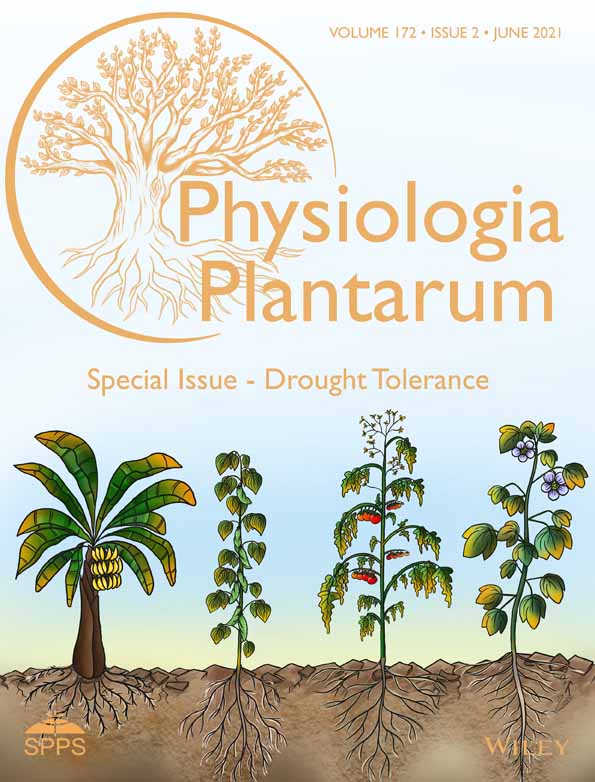Effects of 24-epibrassinolide on plant growth, antioxidants defense system, and endogenous hormones in two wheat varieties under drought stress
Abstract
Drought stress is a major limitation in enhancing agricultural productivity to fulfill the food demand for the world's population. Fertigation of plants with a variety of biochemicals is being used to create drought resistance in wheat; however, the previous work has been limited in addressing these issues in plants at different growth stages. Therefore, a greenhouse study was conducted to ameliorate the drought stress in two wheat varieties (Chakwal-50 and Faisalabad-2008) by foliar application of 24-epibrassinolide (EBL). It was evident that drought stress had a negative effect on the growth, photosynthesis, and yield of wheat plants. EBL significantly enhanced the plant growth both under optimal and drought conditions. EBL improved the plant height, spike length, and the dry weights of roots, shoots, and grains as compared to control. Furthermore, the foliar application of EBL positively enhanced the osmolyte accumulation, increased the amounts of photosynthetic pigments, and improved the gas exchange parameters. The EBL minimized the oxidative stress by reducing electrolyte leakage, malondialdehyde, and hydrogen peroxide contents whereas it enhanced the activities of antioxidant enzymes, such as catalase, superoxide dismutase, and peroxidase under drought stress. The EBL significantly improved the level of stress hormones, such as abscisic acid, indol acetic acid, and cytokinin under drought stress. The growth response of Chakwal-50 was higher than that of Faisalabad-2008 when exposed to EBL under drought stress. Overall, the EBL plays a major role in the enhancement of growth, biomass, yield, and decrease in oxidative damage in wheat under drought conditions, however; field investigations with different doses of EBL are needed before any further recommendation.
Abbreviations
-
- ABA
-
- abscisic acid
-
- CAT
-
- catalase
-
- Chl
-
- chlorophyll
-
- CRD
-
- completely randomized design
-
- EBL
-
- 24-epibrassinolide
-
- EL
-
- electrolyte leakage
-
- H2O2
-
- hydrogen peroxide
-
- HNO3
-
- nitric acid
-
- IAA
-
- indol acetic acid
-
- MDA
-
- malondialdehyde
-
- POD
-
- peroxidase
-
- RFE
-
- rotary film eevaporator
-
- SOD
-
- superoxide dismutase
-
- WHC
-
- water holding capacity
1 INTRODUCTION
Food security is a global issue for the development of sustainable agriculture. In the present scenario, the shortage of freshwater required for agriculture has created serious problems for the production of crops with better nutritional quality in near future (Ali et al., 2019a). Furthermore, a rapid increase in the world population, estimated to reach 9.6 billion by 2050, which will exert a tremendous pressure to fulfill the food demand for an increasing population (Yu et al., 2020). Moreover, recent sudden and extreme climate changes have significantly disturbed the rainfall pattern leading to water scarcity that has negatively impacted crop growth and productivity (Rizwan et al., 2016a; Rizwan et al., 2016b; Rai et al., 2019). Among all the abiotic stresses, drought stress is considered as the most devastating environmental threat to crop production particularly in arid and semiarid regions of the world (Rizwan et al., 2015; Liu et al., 2019; Quiroga et al., 2020). Water shortages are likely to affect life on this planet and prompt crop destruction (Shi et al., 2015; Rizwan et al., 2019a).
Wheat (Triticum aestivum L.) is an important cereal crop which is used as staple food worldwide. Furthermore, it is estimated that 70% more wheat grains will be required by 2050 to feed the increasing world population (Ray et al., 2013). At the same time, wheat productivity is drastically decreasing due to environmental stresses especially drought stress (Rizwan et al., 2015; Adrees et al., 2020). As a result, drought stress could be a major issue that has a serious impact on wheat and other crops, particularly in the near future.
Different approaches are being explored to resolve this issue and to improve the crop yields (Cairns et al., 2012; Gobin et al., 2012). These approaches include the development of stress-tolerant genotypes or enhance stress tolerance by the exogenous applications of various organic compounds, such as vitamins, phytohormones, osmoprotectants, and antioxidants. The response of plants to water stress depends on the growth stage, duration, and species. The most sensitive stage of the plant life cycle is the reproductive stage that significantly influences the final productivity (Fahad et al., 2017; Yang et al., 2019; Ali et al., 2019a). Accordingly, the increase in the use of exogenous chemicals depends on the concentration of the substance used and growth stage of plant (Ali et al., 2019b). It is known that these chemicals are taken up by the plants, translocate, and accumulate to different parts of plants where they participate in cellular activities. They boost up the photosynthetic mechanism by maintaining plant water status and improving the defense system of the plants, which ultimately leads to better crop production (Ali et al., 2019a). The exogenous application of these compounds has improved the nutritional quality of seeds along with the growth and production of cereal crops (Ali and Ashraf, 2011; Jamil et al., 2015).
Phytohormones occupy a distinct place in the list of chemicals that effectively induce stress tolerance in plants via their exogenous application or internal accumulation (Sharma et al., 2019). Among all phytohormones, brassinosteroids (BRs) have been thought to be capable of reducing drought stress in plants (Mohammadi et al., 2020). Brassinosteroids are members of the polyhydroxysteroids which play a key role in a wide variety of morphological and physiological responses in plants such as cell division, stem elongation, activation of enzymes, protein pump regulation, protein synthesis, carbon allocation, photosynthesis activation, fruit development especially under various environmental stresses (Talaat and Shawky, 2012; Filek et al., 2018; Tanveer, 2019). Furthermore, BRs protect the plants against abiotic stresses by activating the defense system by increasing the activities of the antioxidant enzymes, such as superoxide dismutase (SOD), catalase (CAT), peroxidase (POD), and glutathione reductase (GSH) (Zhang et al., 2008; Sytar et al., 2019). It is well known that exogenous application of BRs increased the plant tolerance to drought by reducing oxidative stress, influencing the protein content, accumulation of osmoprotectants, and maintenance of relative water content (Yuan et al., 2010; Talaat and Shawky, 2016). 24-Epibrassinolide (EBL) is a type of brassinosteroid and it is involved in various environmental stresses in plants. Previously, it was reported that BR signaling is involved in various physiological processes and that overexpression of the BRL3 responsible for more accumulation of osmolytes under drought stress in Arabidopsis (Fàbregas et al., 2018b). BRs significantly increased the water uptake and membrane stability with higher carbon dioxide and nitrogen assimilation in wheat plants under stress that can be seen in response to drought tolerance only (Krishna, 2003; Wang et al., 2015). Another piece of evidence indicated that EBL application can improve plant photosynthetic pigments, osmolytes production, antioxidant enzyme activities, and seed yield under drought stress (Hemmati et al., 2018; Zafari et al., 2020). However, the research regarding the effects of EBL under drought stress in plants, especially, in wheat needs more attention. Several studies indicated that EBL-induced growth responses in plants under drought stress; however, little is known about the mechanism conferring EBL-induced drought stress tolerance in wheat. Therefore, this study aims to evaluate the potential role of EBL for morpho-physiological, biochemical, and yield traits in two wheat genotypes under drought stress. We further examine the EBL-based drought stress tolerance in wheat by increasing/decreasing the level of other stress-related hormones under optimal irrigated and drought stress conditions.
2 MATERIALS AND METHODS
2.1 Materials and growth conditions
This research was designed to investigate the impact of 24-EBL on the growth of wheat facing drought stress. 24-EBL was purchased from Sigma-Aldrich and three different concentrations, that is, 1.0, 1.5, and 2.0 μM were prepared from powder by dilution.
Seeds of the wheat varieties (Chakwal-50 and Faisalabad-2008) were provided by the National Agricultural Research Centre (NARC), Islamabad, Pakistan. Seeds of both varieties were sterilized with 2.6% sodium hypochlorite solution and then washed with distilled water to remove extra chloride contents (Rizwan et al., 2019b).
2.2 Pot experiment and treatment
A pot experiment was carried out in glasshouse at the Department of Botany, Pir Mehr Ali Shah (PMAS) Arid Agriculture University, Rawalpindi, Punjab, Pakistan (33°38′57″N–73°04′52″E 513 m). Ten seeds of wheat were sown in each plastic pot (22 cm diameter and 16 cm height) with 5 kg of sandy loam soil. The physiochemical properties of the soil have been given in Table 1. After 2 weeks, four healthy plants of uniform size were maintained in each pot. Initially, pots were irrigated with tap water to 70% of soil water holding capacity (WHC). At 45 days after germination, two different water levels were applied to plants termed as control (70% WHC) and drought stress (40% WHC) for the rest of the experimental duration. At the same time, the foliar application of 24-EBL (1, 1.5, and 2 μM) was given to the plants twice with 5 days interval. The given water levels were checked and maintained twice a week by weighting and adjusting the moisture level of the pots. The experimental layout was a completely randomized design (CRD) with three replicates per treatment. The experimental treatments used were:
| Parameter | Value |
|---|---|
| pH | 7.47 |
| EC dSm−1 | 1.22 |
| Organic matter (%) | 1.96 |
| Phosphorus (mg/kg) | 6.3 |
| Potassium (mg/kg) | 95 |
| Zn (mg/kg) | 0.98 |
| Cu (mg/kg) | 0.72 |
| Mn (mg/kg) | 2.57 |
| Fe (mg/kg) | 2.47 |
| Saturation (%) | 33 |
T0 = control.
T1 = drought.
T2 = 1 μM EBL.
T3 = drought +1 μM EBL.
T4 = 1.5 μM EBL.
T5 = drought +1.5 μM EBL.
T6 = 2 μM EBL.
T7 = drought +2 μM EBL.
2.3 Growth attributes
One hundred twenty days after germination, the plants were harvested at the full maturity stage and separated into above and below-ground parts. Before harvesting, the height of plants and length of spikes were recorded by using a meter rod. The shoots, spikes, and grains represent the above-ground biomass and roots the below-ground biomass. The above-ground parts were washed first with tap water then distilled water and roots were initially washed with tap water then with dilute nitric acid (HNO3) followed by distilled water. The washed wheat parts were dried in an oven at 70°C for about 4 days to obtain constant weight and weighed.
2.4 Photosynthetic pigment contents and gas exchange parameters
The chlorophyll (Chl) and carotenoid contents of fully expended uppermost leaves were measured after 80 days of growth. The Chl a, Chl b, and carotenoid contents were estimated by following the procedure described by (Lichtenthaler, 1987).
The gas exchange parameters, such as photosynthetic rate (Pn), transpiration rate (E), and stomatal conductance (Gs) were recorded by Infrared Gas Analyzer (IRGA) (Li-Cor) between 09:00 and 11:00 am.
2.5 Proline, soluble sugars, and soluble protein
Wheat plant leaves harvested to determine the biochemical profile and analyze the impact of different water regimes on the health status of plants at 80 days after germination. Proline content were estimated by following the protocol given by (Bates et al., 1973), soluble sugars according to the method of (Dubois et al., 1951), and soluble protein contents as per the method of (Bradford, 1976).
2.6 Electrolyte leakage, hydrogen peroxide, and malondialdehyde content
The leaf samples were collected at 80 days after germination to determine the electrolyte leakage (EL), hydrogen peroxide (H2O2), and malondialdehyde (MDA) content. The EL was determined according to the method of (Dionisio-Sese and Tobita, 1998). The MDA contents were estimated as lipid peroxidation in leaves by following the method of (Heath and Packer, 1968) and modified by Dhindsa et al. (1981) and Zhang and Kirkham (1994). The H2O2 were recorded by the procedures described by (Adrees et al., 2020).
2.7 SOD, CAT, and POD activities in leaves
The leaf samples were crushed in pestle and mortar under chilled conditions and homogenized with phosphate buffer (0.5 M, pH 7.8) and subjected to filtration. These samples were centrifuged at 12 000g for 10 min at 4°C. The supernatant was collected and stored for further analysis. CAT activity was determined according to the procedure of (Aebi, 1984). The SOD and POD activities in the leaves were estimated by using the method given by (Zhang, 1992).
2.8 Abscisic acid, indol acetic acid, and cytokinin contents
The plant leaves (1.0 g) were ground in 80% (v/v) methanol, at 4°C with butylated hydroxytoluene (BHT), used as an antioxidant. The extraction was performed at 4°C till 72 h in dark with a subsequent change of solvent at each 24 h. The extracted sample was centrifuged and the supernatant was reduced to aqueous phase using a rotary film evaporator (RFE) at 35°C. The pH of the aqueous phase was adjusted to 2.5–3.0 with 0.1 N hydrochloric acid (HCl) and partitioned four times with half volume of ethyl acetate. The ethyl acetate was dried down completely using RFE. The dried sample was re-dissolved in 1 mL methanol (100%) (Kettner and Dörffling, 1995).
Samples were analyzed on high-performance liquid chromatography (HPLC) using a UV detector and C-18 column (Agilent 1100, Germany). For the identification of hormones, samples filtered through 0.45-millipore filters were injected into the column. Methanol, acetic acid, and water (30:1:70) were used as a mobile phase. Pure hormone samples were used as a standard for the identification and quantification of plant hormones (Sarwar et al., 1992).
2.9 Statistical analysis
The data of this study were means of three replicates with ± standard deviation (sd). All the data were analyzed by software Statistix 8.1 and subjected to a two-way analysis of variance (anova). The means comparison and p-value Tukey test-HSD were used and considered the significance level at <0.05.
3 RESULTS
3.1 Plant morphology, biomass, and photosynthesis
The results of the current study revealed that 24-EBL positively influenced the morphology and growth of both wheat varieties under control and drought-stressed conditions (Figures.1 and 2). The plants exposed to foliar application of EBL and grown under drought conditions were healthy over the drought-stressed plants. The results showed that the plant height and spike length were increased by the higher levels of EBL in both wheat varieties, however, the drought stress reduced the plant height and the spike length drastically. Among all treatments, the T1 considerably decreased the plant height by 42 and 47%, and spike length by 13 and 17% in “Chakwal-50” and “Faisalabad-2008” respectively over the T0 of both varieties. Furthermore, dry weight of roots, shoots, and grains was decreased by 14, 21, 34, and 17, 24, 36%, in “Chakwal-50” and “Faisalabad-2008” as compared to respective T0. Conversely, the positive impact of EBL in wheat was observed under normal and drought conditions which increased with increasing levels of EBL. The EBL treatment at T6 significantly increased the wheat plants height, spike length, dry weight of shoot, root, and grain by 41, 25, 49, 73, 40, and 39, 28, 45, 44, 21% in “Chakwal-50” and “Faisalabad-2008” over the respective T0.

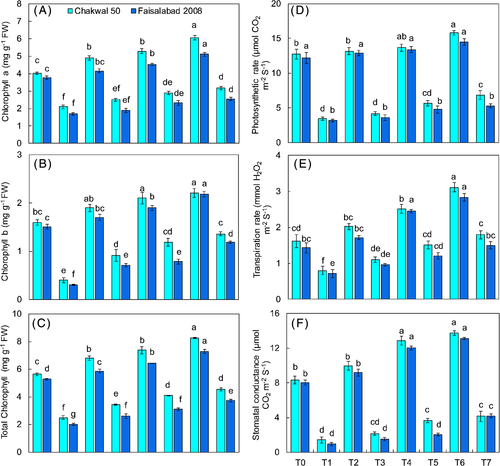
In this study, the drought stress negatively influenced the photosynthetic parameters of wheat such as Chl a, Chl b, total Chl, photosynthetic rate, transpiration rate, and stomatal conductance while exogenous application of EBL positively impacted these parameters compared with the respective controls under optimal irrigated and drought stress condition. Among all treatments, the T1 decreased the Chl a by 47% and 54%, Chl b by 75% and 80%, total Chl by 55% and 62%, photosynthetic rate by 73% and 75%, transpiration rate by 51% and 51%, and stomatal conductance by 82% and 7.9%, respectively in Chakwal-50 and Faisalabad-2008 over the respective T0 treatment. Furthermore, the treatments T2 to T7 positively improved these parameters and maximum enhancement was observed at T6 which increased the Chl a, Chl b, carotenoid, Pn, Gs, and Tr by 50%, 37%, 46%, 24%, 91%, and 39%, in “Chakwal 50” and 37%, 40%, 38%, 18%, 97%, and 63% in “Faisalabad 2008” compared to their T0. In the case of drought stress, the effect of T7 was found better than other treatments in both wheat varieties (Figure 2).
3.2 Proline, soluble sugars, and soluble protein
Drought stress and exogenous application of EBL positively impacted the accumulation of osmolytes such as proline, sugars, and protein in both wheat varieties (Figure 3). Wheat plants under drought stress increased the accumulation of these osmolytes whereas, their accumulation was observed more along with EBL application to stressed wheat plants. The accumulation of proline, sugars, and protein increased by 50%, 78%, and 64%, respectively, in “Chakwal-50” and 70%, 78%, and 81%, respectively, in “Faisalabad-2008” at T1 over the respective T0 (control). Furthermore, their trend was found to be increased with EBL concentration from T2 to T7. However, at the treatment T6, the proline was increased by 35% and 70%, sugars by 43% and 29%, and proteins by 42% and 63% in “Chakwal-50” and “Faisalabad-2008” over their T0, respectively. The foliar application of EBL without drought also enhanced the osmolyte accumulation and maximum was observed at T4. Besides, the response of “Chakwal-50” for osmolyte accumulation was found better than “Faisalabad-2008” as shown in (Figure 3).
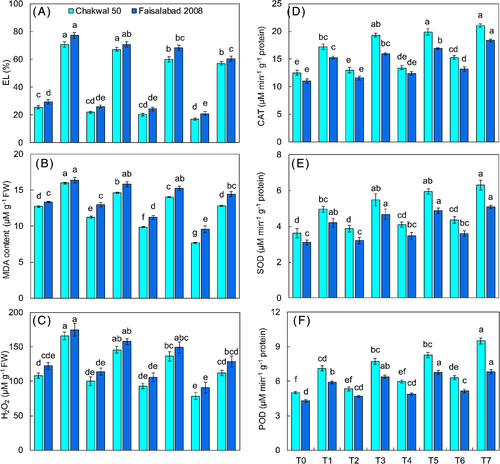
3.3 Oxidative damage and antioxidant defense system
To evaluate the effects of EBL on the physical qualities of the membrane and oxidative stress in response to drought stress, EL, MDA, and H2O2 contents were examined in wheat leaves (Figure 4). Our results showed a significant increase in the EL, MDA, and H2O2 contents in leaves of both wheat varieties under T1, compared to T0, respectively. However, the EBL application declined the above parameters and maximum reduction was noticed at T6 as compared to the rest of the treatments. The treatment T1 increased the EL by 177% and 165%, MDA by 25% and 23%, and H2O2 by 53% and 43% in “Chakwal-50” and “Faisalabad-2008” over the respective T0. In contrast, the EBL application decreased the EL, MDA, and H2O2 at T3, T5, and T7 compared with T1 in both wheat varieties. Therefore, the T6 considerably reduced EL 34% and 29%, MDA 40% and 28%, and H2O2 by 27% and 26% in “Chakwal-50” and “Faisalabad-2008” over their T0.
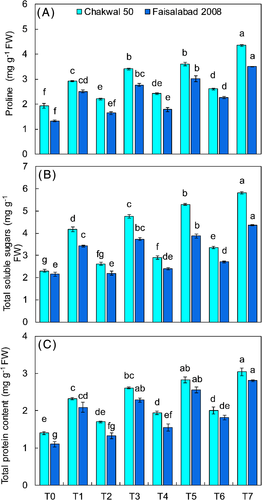
Drought stress (T1) increased the activities of antioxidant enzymes, such as CAT, SOD, and POD in leaves of wheat as compared to T0 (Figure 4 D–F). The increasing trend in the activities of these enzymes was linear on exposure to EBL under drought stress whereas, without drought, the maximum enhancement was observed at T6. The treatment T1 increased CAT by 37% and 38%, SOD by 36% and 35%, and POD by 42% and 34% in “Chakwal-50” and “Faisalabad-2008,” respectively, over the T0. While the EBL concentration-based maximum increase was noted in T6 which improved the CAT, SOD, and POD by 22%, 19%, and 26% in “Chakwal-50” and 19%, 16%, and 18% in “Faisalabad-2008” over the respective T0. These findings elucidate the potential role of EBL under drought stress to mitigate oxidative damage by improving the plant defense system.
3.4 Accumulation of abscisic acid, indol acetic acid, and cytokinin
Drought stress and exogenous application of EBL significantly impacted the contents of abscisic acid (ABA), indol acetic acid (IAA), and cytokinin in wheat (Figure.5). Drought stress increased the content of ABA and maximum values were obtained at T1 in both wheat varieties. There was 233% and 236% increase in ABA was recorded at T1 in “Chakwal-50” and “Faisalabad-2008,” respectively, over the T0, however, its content was decreased with EBL application under drought stress at T2, T4, and T6 compared with T1. Furthermore, the content of IAA and cytokinin decreased under drought stress while EBL positively enhanced the IAA and cytokinin content in wheat with or without drought. The maximum decrease in IAA was 84% and 87%, and cytokinin was 43% and 58% in “Chakwal-50” and “Faisalabad-2008,” respectively, at T1 over the T0. One the other hand, T6 significantly enhanced the IAA and cytokinin by 89% and 50% in “Chakwal-50”, and 64% and 36% in “Faisalabad-2008” compared with respective T0. By comparing both varieties of wheat, “Chakwal-50” responds efficiently to all given treatments of EBL with or without drought stress.
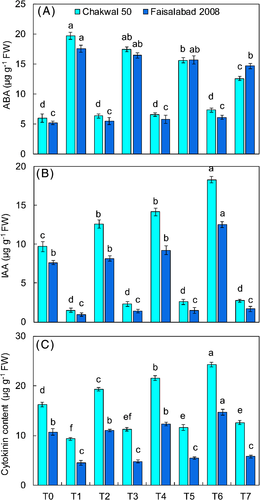
4 DISCUSSION
To reduce the drastic effects of drought stress on plants, different approaches are being used including the exogenous application of different chemicals/phytohormones through different methods. Among these methods, the exogenous/foliar application of such chemicals is very efficient through which applied compounds can readily be absorbed by plant leaf and translocated to other parts where they regulate plant cellular metabolism (Ali and Ashraf, 2011). In the present study, drought stress significantly reduced the growth and biomass production of wheat associated with the decline in photosynthetic activity, osmolyte production, photosynthetic pigments, antioxidants activity, and an increase in oxidative damage via excessive production of reactive oxygen species, and less production of osmoprotectants. Such damaging effects of drought stress on studied parameters are well-known mechanisms as presented in previous literature (Trebst et al., 2002; Ali et al., 2019a). However, we found the efficient role of different doses of EBL to enhance plant growth, biomass, and grain yield under normal and stressed conditions (Figure.1). The significant improvement in these parameters due to exogenous application of EBL might be due to its active role in various physiological processes possibly due to its translocation to different plant parts where it performed an important role in plant stress tolerance (Zhao et al., 2017). Brassinosteroid efficiently controls plant development by regulating various physiological mechanisms including cell division and growth, photosynthesis, protein synthesis, hormonal regulation, and activation of different enzymes (Khan et al., 2012, Liu et al., 2018, Ali, 2019; Tanveer, 2019). Previous reports revealed that foliar/exogenous application of EBL was effective in the regulation of plant development and physiological processes under stress conditions (Zhao et al., 2017; Mohammadi et al., 2020). Furthermore, from the results, it is clear that exogenous EBL improved the photosynthetic efficiency of wheat and alleviated the photosynthetic inhibition by drought stress (Ali and Ashraf, 2008).
The present study revealed the increased production and accumulation of osmolytes, such as proline, sugars, and proteins in wheat under drought stress; however, the EBL application showed significant improvements in osmolyte production in wheat under drought condition (Figure 3). Proline, an amino acid act as a scavenger for ROS, and its accumulation is just a sign of stress (Mohammadi et al., 2020). Proline and sugars are the main agents that produce and provide tolerance to plants under drought stress and maintain osmotic homeostasis in plants (Parvaiz and Satyawati, 2008; Fariduddin et al., 2013). Similar to our study, the exogenous application of brassinosteroid have increased the level of proline, sugars, and proteins in plants under water stress condition (Zhang et al., 2015; Khamsuk et al., 2018; Kaya et al., 2020).
The EBL application considerably reduced the oxidative damage by decreasing EL, MDA, and H2O2 and enhanced the SOD, CAT, and POD activities in wheat under drought stress (Figure 4). Reports revealed that drought stress increased the EL, MDA, and H2O2 by scavenging the activities of various protective chemicals such as osmoprotectant, antioxidants, and secondary metabolites, etc. (Ali et al., 2019a; Adrees et al., 2020). EBL might have the ability to reduce MDA by decreasing membrane damage (peroxidation) and maintaining the structure and stability of membrane which could enhance the stress tolerance in plants (Talaat and Shawky, 2012; Zhao et al., 2017). On the other hand, drought stress enhanced the activities of antioxidant enzymes which reflects the inhibition of ROS produced under drought conditions. There was a strong correlation between oxidative stress caused by drought and the activities of antioxidant enzymes (Adrees et al., 2020). The CAT converts O2 into H2O2 and SOD transforms into water and oxygen (Rizwan et al., 2019a). An increase in antioxidant enzyme activities suggests that plants are needed to cope with drought stress by eliminating ROS (Mohammadi et al., 2020). We reported the foliar application of EBL enhanced the antioxidant enzyme activities in wheat under normal and drought conditions over the control. The enhancement in their activity on exposure to EBL might be due to the effect of EBL on transcriptional or translational regulation of genes responsible for their functioning (Bajguz and Hayat, 2009; Mohammadi et al., 2020). Some previous reports have shown a significant augmentation in antioxidant enzyme activities on exposure to EBL in different plant species (Babalık et al., 2019; Kretynin et al., 2019; Ahanger et al., 2020). Furthermore, EBL application reduces the oxidative damage caused by drought stress via enhancing the activities of antioxidant enzymes, relative water content, soluble proteins, and reducing the synthesis of MDA which lead to increase in photosynthesis and ultimately improve plant growth and yield (Filek et al., 2018; Tanveer, 2019). Drought stress increased and the application of EBL reduced the ABA in wheat plants leaf. While the IAA and cytokinin contents were decreased under drought; however, EBL enhanced their content in normal and stressed conditions (Figure 5). The increasing trend of IAA and cytokinin and decreasing level of ABA was noticed along with an increase in EBL concentration on wheat under drought stress. It has been reported that ABA is responsible for stomatal movements and production of osmolytes to maintain osmotic adjustment, however, its high concentration can also restrict the plant growth (Daszkowska-Golec, 2016; Crizel et al., 2020). Interactions among various hormones under drought stress confer the tolerance and resistance of plant species. Drought stress signs the production of ROS which enhances the level of indigenous ABA to close stomata; however, brassinosteroid converges the ABA signaling pathways to that trigger stress responses. These stress responses depend upon the various physiological processes, such as osmolyte production and accumulation, stomatal regulation, root growth, and maintenance of photosynthetic functions (Gupta et al., 2020). In the case of IAA and cytokinin, it has been suggested that both these are involved in the apical growth of root and shoots but their functions vary with type of stress and plant species (Sharma et al., 2019). Cytokinin is majorly involved in cell cycle regulation, cell division, and delay in leaf senescence which could reflect the improved growth of plants in the presence of high cytokinin, whereas, its response is not limited to time duration (Alvarez et al., 2008). Our results demonstrated that EBL enhanced the content of IAA and cytokinin which might have improved the growth of wheat under drought stress. Studies have depicted that EBL interacts with other hormones and osmoprotectants, such as polyamines, glycine betaine, and proline which function as molecular chaperons to scavenge the ROS and enhance the resistance of plants against stress (Sharma et al., 2019). The changes in the level of these hormones in wheat due to exogenous application of EBL suggested that it controls various physicochemical processes in the plant under stress condition and regulate the synthesis of key osmoprotectants (Fàbregas et al., 2018a). Overall, the results of the present study revealed that foliar application of EBL had great tolerance against drought stress in wheat which improved with an increase in EBL concentrations. Additionally, a high level of EBL significantly augmented the growth, physiology, and yield of wheat under water deficit conditions which might provide clear directions to the agricultural scientist with respect to the use of EBL for better crop production. However, field studies are required for further investigations.
5 CONCLUSIONS
Foliar application of 24-epibrassinolide improved the drought stress tolerance in wheat with respect to growth, biomass production, and yield. Such improvement can easily be observed in photosynthetic pigments, oxidative damage, osmolyte, and antioxidant defense system especially hormonal accumulation. A higher concentration of EBL was found better to increase drought tolerance in wheat in terms of successful growth and yield production. The response of “Chakwal-50” to above-explained parameters was better than the “Faisalabad-2008” variety which depicted the varietal capability towards the applied EBL doses. In addition, this study will provide evidence for genetic research to develop transgenic plants and their successful test under field conditions. The EBL-based gene expression at a specific developmental stage, in specific organ or tissue in response to drought stress will make possible generation of transgenic plants that can be grown under field condition with minimal yield losses. Overall, this study could provide a clear understanding for researchers to find out the actual molecular mechanism behind the EBL based tolerance mechanism in wheat by which they can carry further investigation at cellular level.
AUTHORS CONTRIBUTION
Imran Khan, Samrah Afzal Awan, Rizwana Ikram and Nosheen Akhtar. participated in the laboratory work, data collection and interpretation, discussion as well as writing the paper. Noshin Ilyas developed the concept and designed the experiment. Imran Khan, Samrah Afzal Awan, and Noshin Ilyas participated in writing the paper; Noshin Ilyas, Muhammad Rizwan, Riyaz Z. Sayyed, Humaira Yasmin, and Shafaqat Ali participated in data analysis, writing and editing the paper. All the authors read and approved the final manuscript.
CONFLICT OF INTEREST
All authors declared that there is no conflict of interest.
Open Research
DATA AVAILABILITY STATEMENT
The data that support the findings of this study are available from the corresponding author upon reasonable request.



